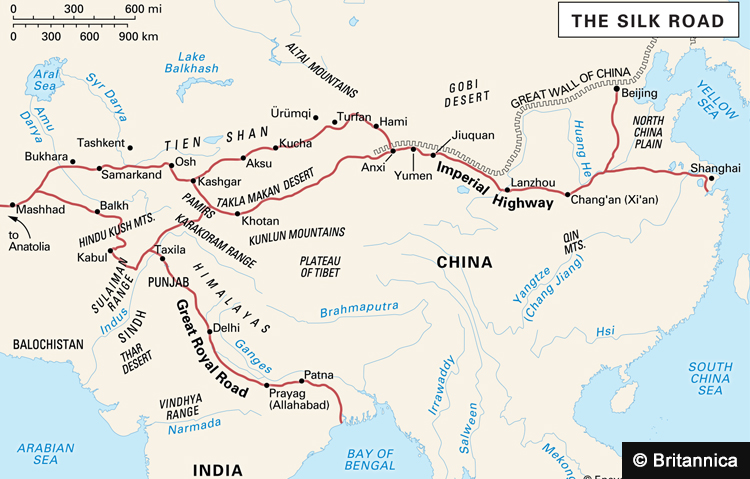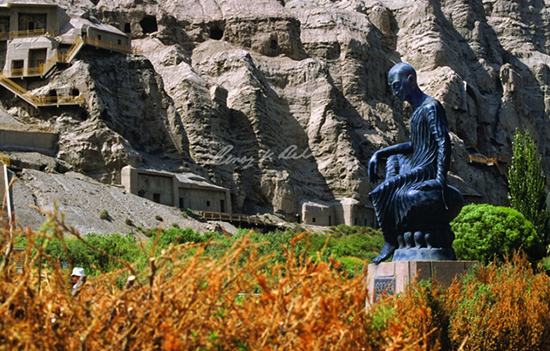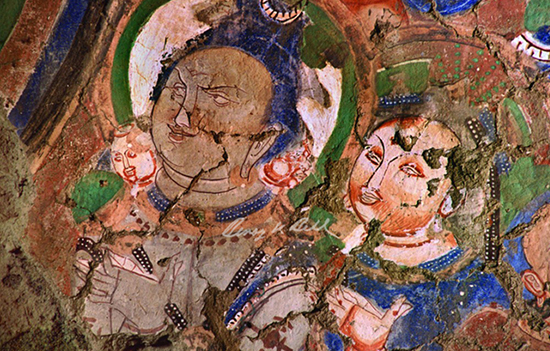- This gives a background to the paper followed by The Begining of the Discovery of Sanskrit manuscripts.
This was the topic of an International seminar organized by the Bharatiya Vidya Bhavan in New Delhi. Papers presented have now taken the form of a book. We present book introduction in smaller parts. Note “Central Asia is a
region in Asia which stretches from the Caspian Sea in the west to China and
Mongolia in the east, and from Afghanistan and Iran in the south to Russia in
the north, including Kazakhstan, Kyrgyzstan, Tajikistan, Turkmenistan, and Uzbekistan-Editor.
Sanskrit
has played a historical role in the development of human society crossing the
boundaries of India, beyond the Himalayas in the north and oceans in the south.
It has been a primal force to inspire and uplift on the physical and abstract
planes.
In the
northwest the Sanskrit texts travelled beyond Gandhara, the region of modern
Peshawar, went northwards and northeastwards. Large scale monasteries were
constructed under royal patronage.
By the
3rd century AD Buddhism was flourishing in the lands beyond
Sogdiana, in Khotan and Krorayina kingdoms on the northern frontiers of China.
Profound and subtle teachings contained in the Sanskrit scriptures composed,
commented on or propagated by great scholars like Nagarjuna, Vasubandhu,
Asanga, and a large number of other eminent Indian scholars became the glory of
those lands. Chinese monks and translators used to study with the monks in
Kucha and Khotan and later they used to come to India ignoring the great perils
of deserts and mountains to bring back Sanskrit manuscripts, divine images and
Buddhist relics.
Exchanges
between India and the kingdoms of Central Asia led to sharing of culture
efflorescence for centuries in the first millennium. Silk and jade, horses and
valuable commodities changed hands, but the most lasting treasure that traveled
along the route was Sanskrit texts. People with multilingual skills translated
the sutras into the classical languages of Central and East Asia. Cultures of
the east and the west blended to create an intellectual aura of high order
which exists till today in China, Korea and Japan.
Their
arts of painting, sculpture and architecture, drama, dance and music, languages
and literatures, scripts and calligraphy, principles of arts, rituals and
ceremonies, jyotish and ayurveda, chemistry and metallurgy, are
reflections of the essence of the mission, wisdom, life and legacy of around
250 Indian masters and Chinese pilgrim-monk-scholars who disseminated the
wisdom to these areas from the 2nd to the 13th
century.
These
texts cover sacred and secular sciences, and social and political value
systems. They are valuable documents to trace the lost legacy of Indian
masters and the impact of Buddhism on Central and East Asian performing and
visual arts.
The scripts used in Central and East Asia in the classical times are historically
important to trace the development of Indian scripts. A large number of
Sanskrit texts lost in India may be recovered from abroad.
The Silk Route runs from China to Rome and
to India around the vast expanses of deserts with rivers flowing from the
surrounding mountain ranges. It was named after silk, one of the chief
mercantile commodities. It ran through the vast deserts of Taklamakan, Lop and
Gobi, bound by long chains of Tien Shans and Kunluns to the north and south and
Pamirs to the west bifurcating at Kashgarh and meeting at Dunhuang. The northern route goes via Samarkand,
Kasgarh, Tumshuk, Aksu, Kucha, Karashahr, Turfan and Hami and the southern
route via Yarkand, Khotan, Keriya, Cherchen and Miran.
Chinese and Indian scholars traveled through
these routes in search of wisdom texts and propagation of Buddhism, and western
explorers went there in search of invaluable cultural treasures.
An incalculable treasure of Sanskrit
manuscripts was buried under sand after devastation of monastic establishments.
Great adventurers, archaeologists and explorers began digging the deserted and
devastated kingdoms, and glorious cities enlivened by the activities of
Buddhist community. Numerous cave temples and monasteries were discovered.
Whatever was collected, is fragmentary.
But a missing chapter in the history of India’s cultural relations with Classical Central Asia is being documented since the end of nineteenth century.
 See Takla Makan Desert area.
See Takla Makan Desert area.
Beginning of discovery of
Sanskrit manuscripts
Lieutenant (now Major General) H Bower
discovered the first Sanskrit manuscript from the Silk Route who had gone to
Kucha on a confidential mission from the govt. of India in 1890 in quest of a
murderer of Dalgleish. It is a fifth century medical manuscript written on
birch bark in Sanskrit. On his return he
took the manuscript to Shimla whence he forwarded it to the President of the
Asiatic Society of Bengal. The first decipherment of the manuscript published
in its proceedings (April 1891) started the whole modern movement of the archeological
explorations of Eastern Turkistan.
Prof. G Buhler announced the discovery in an issue of Vienna Oriental Journal (1891, pg. 103). The Russian Archeological Society addressed Mr. Petrovsky, the Russian Consul General in Kashagar to collect similar manuscripts. The Ptrovsky collection went to the Imperial Library in St. Petersburg in 1892-3. Prof. Serge d’Oldenburg published its report and specimens in the Transactions of the Imperial Russian Archeological Society (vol. viii, pp 47 ff). It was followed by Rev. F. Weber, Moravian missionary in Leh who had a meeting with Lt. Bower and a curiosity aroused and acquired manuscripts in 1892. A report on Weber collection was published in (vol. LXII, 1893, pp 1 ff) in the journal of Asiatic Society of Bengal.
 Statue of Kumarajiva, Kizil Caves, Kucha, Xinjiang Uygur Autonomous Region, China. Pic
by Benoy K Behl
Statue of Kumarajiva, Kizil Caves, Kucha, Xinjiang Uygur Autonomous Region, China. Pic
by Benoy K Behl
Major expeditions
From British India A.F. R. (Rudolph) Hoernle, a scholar
of Indo-Aryan languages and Sir Aurel Stein, a Hungarian, went on expeditions
to Central Asia. Swedish explorer, Sven Hedin, was inspired by Aurel Stein, to
arrange an expedition to Chinese Central Asia in 1900. The caves of
Bezeklik were first explored by von Le Coq from Germany in 1905.
Representatives of Baron Otani went for explorations in 1908-9.
During 1907–09 expedition, Kozlov made perhaps the greatest Russian contribution to Silk Road archaeology, when he excavated the ancient, sand-buried city of Kharakhoto. Hermitage Museum in St. Petersburg keeps his
collections. A French expedition
was led by Paul Pelliot to investigate these ruins of monasteries and temples. The Otani expeditions from Japan refer to the three trips to Central Asia between 16 August 1902 and 10 July 1914, carried out under the leadership of Otani Kozui (1876–1948), the 22nd abbot of the Nishi Honganji monastery in Kyoto. The aim of the expeditions was to investigate Buddhist sites and to collect ancient manuscripts.
Stein's original material was divided between London (the British Museum, the India Office Library and the Victoria and Albert Museum) and National Museum in India. By 1982, the majority of the London manuscripts and photographs had been transferred to the British Library,
where they remain, with the British Museum. There are
smaller collections from the first expedition in the Indian Museum, Calcutta
and in Pakistan in the Oriental Museum, Lahore. Apart from the Stein
collection, the British Library includes Central Asian manuscripts collected by
the Government of India, usually referred to as the Hoernle Collection.
The discoveries from Central Asia were exciting for the scholars. The y began to piece together the scattered evidences of Indian culture outside it and began to translate into their languages. The most brilliant was Prof. M Sylvain Levi who wrote, “Mother of wisdom, India gave mythology to her neighbors. … … Mother of law and philosophy, she gave to three quarters of Asia, a god, a religion, a doctrine, an art…..”. Thus Sanskrit is esteemed as a treasure of high order, eternal, life giving and ever fresh in classical Asia.
Major collections
The manuscripts preserved in each museum
and collection are discovered from different sites.
F Rudolf Hoernle inspired by Bower manuscript and the collection of N F Petrovsky wrote to the Home Secretary of Govt. of India to send political agents in different parts of Central Asia to search Sanskrit manuscripts. His suggestion was taken up and thirty-three consignments of manuscripts were sent for decipherment. These became known as Hoernle collection or the British Collection of Antiquities from Central Asia, now kept at the British Library, London. Hoernle had also purchased manuscripts from Leh and sold them to Bodleian Library, Oxford. The manuscripts in Brahmi script from Sir Aurel Stein’s collection were also sent to Hoernle giving him the task of equitably dividing them between the British Museum and the Govt. Of India, which are now preserved at the National Museum, New Delhi.
From 1891 to 1918 Hoernle worked
extensively on the Central Asian collection focusing on Inidan medicine,
epigraphy, palaeography, and especially the decipherment of the material
written in Khotanese.
Hoernle
intended to make the material widely available. Finding it difficult to edit
all the manuscripts he called for assistance from other scholars. Among several
well known scholars who came forward to assist him were Mr. F W Thomas, Dr. L D
Bernett, Prof. Luders, Mr. Kaikioku Watanabe, Sten Konow and Leumann. Fragments
were identified, transliterated and annotated for being published.
Khotan
Khotan was a famous for Sanskrit manuscripts. From early times Chinese monsk were sent to Khotan to acquire Buddhist texts. Khotanese and Indian monks used to visit China carrying sacred wisdom texts. They were sent to other cities also like Loyang. Many manuscripts were discovered from Khotan by the locals and sold to various buyers.
Sometimes portions of manuscripts were sold to different buyers. For example Kashgar manuscript of Saddharmapundarika-sutra was acquired by N F Petrovsky in 1930 but as late as 1923 E Trinkler bought six folios of the same manuscript. A stein had collected manuscripts from Khadaliq.
Khotanese
A large number of Sanskrit manuscripts are written in Khotanese script which is a variety of Aramaic alphabet of Syria. The script was used in north western India and was carried thence to the Indian settlements of Central Asia beyond Khotan. P O Skjaervo published a catalogue of Khotanese texts in the British Library.
 Shiva and Parvati, Mural, Kizil Caves, Kucha, Xinjiang Uygur Autonomous Region, c. 6th
Century CE, China. Pic by Benoy K Behl.
Shiva and Parvati, Mural, Kizil Caves, Kucha, Xinjiang Uygur Autonomous Region, c. 6th
Century CE, China. Pic by Benoy K Behl.
Kucha
A consignment that Hoernlew received came
from Kucha where Mahayana texts were written in Sanskrit and Khotanese there.
Dunhuang
Stein not only purchased but excavated
manuscript material during his expeditions in Khotan. The most comprehensive
catalogues of fragments are from his collection. His finds were described,
identified and transliterated in Ancient Khotan, Serindia and Annermost
Asia.
During his first expedition in December
1900 he was guided to Dandan Uiliq by the locals. Several manuscript remains
were already sold from the same ruins by treasure seeking parties before Stein
reached there. He visited Khadaliq during his second expedition. Identification
of the fragments that he collected from there ascertain that the
origin/provenance of the manuscripts at Crosby collection (Washington DC),
Hoernle Colelction (London) and Petrovsky collection (St. Petersburg) are the
same.
Author Prof. Dr. Shashibala is Dean, Centre of Indology, Bharatiya Vidya Bhavan, New Delhi.
Also
read
1. The Tarim Basin in Xinjiang was Kashmir’s twin - After being converted to Islam, the
descendants of the previously Buddhist Uyghurs in Turfan soon lost memory of
the origins of the caves.
2. The
Rama Story and Sanskrit in ancient Xinjiang
3. The
Saka Lands linking India and Europe
4. Pictures
of Cultural Documentation (has Buddha and Shiva too) in Central Asia
5. Pictures
of Northern Frontiers of Buddhism (has Mongolia, Buryatia in Siberia)